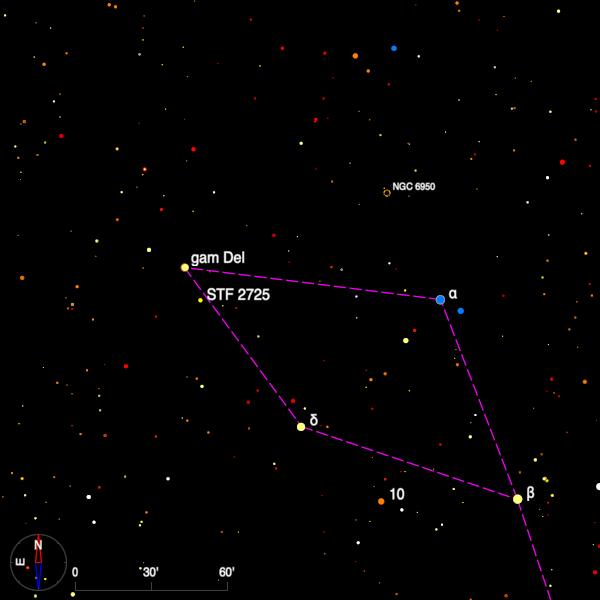September 2022 - Double Star of the Month
I noted, rather surprisingly, that this column had yet to deal with gamma Delphini (20 46 39.50 +16 07 27.5) so this is a good opportunity to do so. One of the finest pairs in the sky because of its glorious colours, gamma has been known since the time of James Bradley (1755).

The stars are magnitudes 4.4 and 5.0 and they are currently 8".8 apart in position angle 264 degrees. Although there has been little motion between the two since Bradley's time, an orbit with a period of 3249 years has been calculated which predicts a closest approach of 0".8 in around 2300. The apparent orbit as plotted in the USNO 6th orbital catalogue shows little, if any, sign of orbital curvature but the stars have the same parallax, if only just.
The results of radial velocity observations of both stars with the intention of finding exoplanets have not confirmed any.
Smyth observed the pair on many occasions and found colours of yellow and light emerald, whilst I made them golden yellow and blue-green when I first observed them during a youthful survey of double stars in 1968. Thirty arc-minutes south preceding gamma is the pair STF 2725, also a long-period binary. It has stars of magnitude 7.5 and 8.2 at 12 degrees and 6".2.
Right on the border between Sagittarius and Microscopium, R 321 (20 26 52.95 -37 24 10.5) is a fine binary which is well worth sweeping for.

Found by H. C. Russell at Sydney Observatory, this pair has a period of 186.4 years and the motion of the stars is in decreasing position angle (retrograde). In 1880, when first observed, the stars according to Russell were 1".1 apart , then by 1950 they had closed up to 0".26 before later opening out. At the present time they are 1".6 apart, with widest separation occurring around 2029. The stars have visual magnitudes of 6.2 and 7.9 and are orange in hue - each is an early-K dwarf. They should be comfortably divided with 10 or 12-cm.
Whilst in the area, move about 3 degrees SSW, and you will find DUN 230 (20 17 49.68 -40 11 05.1) which is an easy object for the smallest aperture. The two components are both of late-F spectral type and whose visual magnitudes are 7.4 and 7.7; the stars are 9".7 apart in PA 117 degrees, and lie 257 light-years away.
Bob Argyle - Double Star Section Director